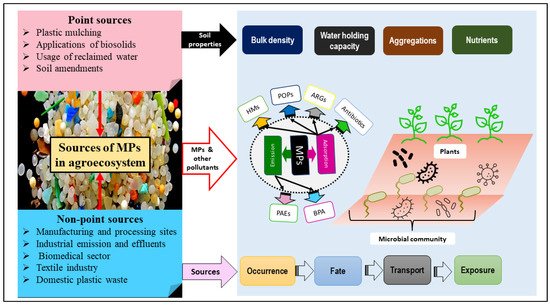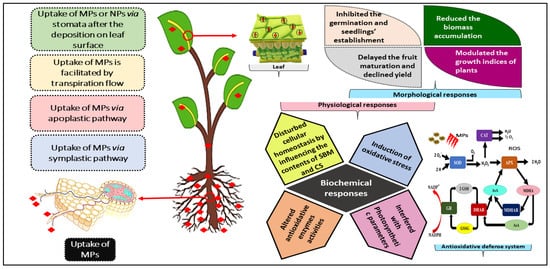Microplastics (MPs) are ubiquitous and constitute a global hazard to the environment because of their robustness, resilience, and long-term presence in the ecosystem.
- plastic pollution
- higher plants
- morpho-physiological responses
1. Introduction
Owing to the extensive use of plastic, MPs are pervasive, including in the atmosphere, soils, seawater, and freshwater, as well as in the sediments of Artic Lake [10][6]. Apart from the contamination caused by their widespread use, MPs have been reported to adsorb a variety of inorganic and organic pollutants, due to their small volume and high specific surface area, resulting in the accumulation of pollutants, posing a slew of risks to the surrounding flora and fauna, including humans [11][7]. Further, they can interact with a vast spectrum of biota because of their long lifetime, widespread distribution across habitats, and small size; yet evidence on MP exposure and the associated repercussions is still sparse in the literature. Therefore, many researchers have explored the impacts of MPs on a variety of marine and freshwater organisms over the last decade, but the situation is reversed in the case of terrestrial plants. However, plants are key primary producers in terrestrial ecosystems and are also equally as vital to the environment as other organisms, and therefore, they should be carefully investigated as part of MP research.
2. IEmerginteractions of MPs with Agroecosystems andg Threat of Microplastic Pollution to Terrestrial Plants
2.1. MPs in Agroecosystems

2.2. Mechanism of MP Uptake in Plants
2.3. MPs and Plants
Germination is a critical stage in the life cycle of plants, and it begins with the absorption of water, which includes establishing the metabolic reactions required for seed germination [40][22].
The influence of NPs and MPs on the growth of terrestrial plants has received less investigation. Soils with MPs-containing sludge promoted tomato plant growth while delaying and reducing fruit output. However, the authors stated that more research is needed to confirm these findings and clarify the mechanisms of MPs’ potential effects on plants [44][23].
Crops (plants) are vital for human survival and ecological health. However, there are several abiotic and biotic stressors, including MPs, that decrease the economic outcomes of edible plants. According to a substantial number of studies, MPs have been found to have both negative and positive effects on plants’ performances [46,47][24][25]. Further, MPs not only impact the soil properties, soil fauna, and microbes but also interfere with the metabolic activities of plants via their uptake and accumulation. In plants, the accumulation of MPs in their organs and the adherence to the surfaces of the roots or seeds has been linked with the decrement in the water and nutrient uptake [47,48][25][26].
It is demonstrated that MPs can accumulate in plants, which is directly related to altered cellular homeostasis, which eventually impacts the plant economic outcomes and raises food security concerns. The detailed scheme of the uptake and morpho-physiological implications in plants is depicted in Figure 42.

References
- Kumar, P.; Kumar, A.; Kumar, R. Phytoremediation and Nanoremediation. In New Frontiers of Nanomaterials in Environmental Science; Kumar, R., Kumar, R., Kaur, G., Eds.; Springer: Berlin/Heidelberg, Germany, 2021; pp. 281–297.
- Issac, M.N.; Kandasubramanian, B. Effect of microplastics in water and aquatic systems. Environ. Sci. Pollut. Res. 2021, 28, 19544–19562.
- Thompson, R.C.; Olsen, Y.; Mitchell, R.P.; Davis, A.; Rowland, S.J.; John, A.W.G.; McGonigle, D.; Russell, A.E. Lost at Sea: Where Is All the Plastic? Science 2004, 304, 838.
- Jambeck, J.R.; Geyer, R.; Wilcox, C.; Siegler, T.R.; Perryman, M.; Andrady, A.; Narayan, R.; Law, K.L. Plastic waste inputs from land into the ocean. Science 2015, 347, 768–771.
- Shah, F.; Wu, W. Chapter Five—Use of plastic mulch in agriculture and strategies to mitigate the associated environmental concerns. In Advances in Agronomy; Sparks, D.L., Ed.; Academic Press: London, UK, 2020; Volume 164, pp. 231–287.
- Bergmann, M.; Mützel, S.; Primpke, S.; Tekman, M.B.; Trachsel, J.; Gerdts, G. White and wonderful? Microplastics prevail in snow from the Alps to the Arctic. Sci. Adv. 2019, 5, eaax1157.
- Menéndez-Pedriza, A.; Jaumot, J. Interaction of Environmental Pollutants with Microplastics: A Critical Review of Sorption Factors, Bioaccumulation and Ecotoxicological Effects. Toxics 2020, 8, 40.
- Boucher, J.; Friot, D. Primary Microplastics in the Oceans: A Global Evaluation of Sources; IUCN: Gland, Switzerland, 2017; p. 43.
- Briassoulis, D.; Babou, E.; Hiskakis, M.; Kyrikou, I. Analysis of long-term degradation behaviour of polyethylene mulching films with pro-oxidants under real cultivation and soil burial conditions. Environ. Sci. Pollut. Res. 2015, 22, 2584–2598.
- Monkul, M.M.; Özhan, H.O. Microplastic Contamination in Soils: A Review from Geotechnical Engineering View. Polymers 2021, 13, 4129.
- Zhou, J.; Wen, Y.; Marshall, M.R.; Zhao, J.; Gui, H.; Yang, Y.; Zeng, Z.; Jones, D.L.; Zang, H. Microplastics as an emerging threat to plant and soil health in agroecosystems. Sci. Total Environ. 2021, 787, 147444.
- Ya, H.; Jiang, B.; Xing, Y.; Zhang, T.; Lv, M.; Wang, X. Recent advances on ecological effects of microplastics on soil environment. Sci. Total Environ. 2021, 798, 149338.
- Hüffer, T.; Hofmann, T. Sorption of non-polar organic compounds by micro-sized plastic particles in aqueous solution. Environ. Pollut. 2016, 214, 194–201.
- O’Kelly, B.C.; El-Zein, A.; Liu, X.; Patel, A.; Fei, X.; Sharma, S.; Mohammad, A.; Goli, V.S.N.S.; Wang, J.J.; Li, D.; et al. Microplastics in soils: An environmental geotechnics perspective. Environ. Geotech. 2021, 8, 586–618.
- Yu, F.; Yang, C.; Zhu, Z.; Bai, X.; Ma, J. Adsorption behavior of organic pollutants and metals on micro/nanoplastics in the aquatic environment. Sci. Total Environ. 2019, 694, 133643.
- Zhang, P.; Sun, H.; Ma, J.; Li, B. The structure of agricultural microplastics (PT, PU and UF) and their sorption capacities for PAHs and PHE derivates under various salinity and oxidation treatments. Environ. Pollut. 2020, 257, 113525.
- Panigrahi, S.; Velraj, P.; Subba Rao, T. Chapter 21—Functional Microbial Diversity in Contaminated Environment and Application in Bioremediation. In Microbial Diversity in the Genomic Era; Das, S., Dash, H.R., Eds.; Academic Press: London, UK, 2019; pp. 359–385.
- Dietz, K.-J.; Herth, S. Plant nanotoxicology. Trends Plant Sci. 2011, 16, 582–589.
- Wang, W.; Yuan, W.; Xu, E.G.; Li, L.; Zhang, H.; Yang, Y. Uptake, translocation, and biological impacts of micro(nano)plastics in terrestrial plants: Progress and prospects. Environ. Res. 2021, 203, 111867.
- Li, H.; Zhang, L.; Lu, H.; Ma, J.; Zhou, X.; Wang, Z.; Yi, C. Macro-/nanoporous Al-doped ZnO/cellulose composites based on tunable cellulose fiber sizes for enhancing photocatalytic properties. Carbohydr. Polym. 2020, 250, 116873.
- Giorgetti, L.; Spanò, C.; Muccifora, S.; Bottega, S.; Barbieri, F.; Bellani, L.; Castiglione, M.R. Exploring the interaction between polystyrene nanoplastics and Allium cepa during germination: Internalization in root cells, induction of toxicity and oxidative stress. Plant Physiol. Biochem. 2020, 149, 170–177.
- Kumari, A.; Rajput, S.; Arora, S.; Kaur, R. Temperature Rising Patterns and Insights into the Impacts of Consequent Heat Stress on Edible Plants. Environ. Stress Physiol. Plants Crop Product. 2021, 56, 56–74.
- Hernández-Arenas, R.; Beltrán-Sanahuja, A.; Navarro-Quirant, P.; Sanz-Lazaro, C. The effect of sewage sludge containing microplastics on growth and fruit development of tomato plants. Environ. Pollut. 2021, 268, 115779.
- Velasco, E.A.P.; Galindo, R.B.; Aguilar, L.A.V.; Fuentes, J.A.G.; Urbina, B.A.P.; Morales, S.A.L.; Valdés, S.S. Effects of the Morphology, Surface Modification and Application Methods of ZnO-NPs on the Growth and Biomass of Tomato Plants. Mol. 2020, 25, 1282.
- Khalid, N.; Aqeel, M.; Noman, A. Microplastics could be a threat to plants in terrestrial systems directly or indirectly. Environ. Pollut. 2020, 267, 115653.
- Liu, Y.; Guo, R.; Zhang, S.; Sun, Y.; Wang, F. Uptake and translocation of nano/microplastics by rice seedlings: Evidence from a hydroponic experiment. J. Hazard. Mater. 2022, 421, 126700.
